RENAISSANCE
ART
"Simplicity is the ultimate
sophistication" Leonardo Da Vinci
“My works are the issues of pure and simple experience, who
is the one true mistress. These rules are sufficient to enable you to know the true from the
false”. Da Vinci
Renaissance means “rebirth”. The
ideas of the Renaissance first emerged in the city-state of Florence, Italy in the 14th century. It reached
its height there in the 15th century then spread to the rest of Europe in the 16th century. The Renaissance was at
first a rediscovery by scholars (called Humanists) of the writings of ancient Greeks and
Romans.
15th and 16th century intellectuals coined the term “Renaissance”
to assert the superiority of their own age over the “middle” or “dark” ages – a period of light, awakening,
spring, youth, vigor and innovation.
Renaissance paintings must be read, for they were consciously
designed to tell stories, teach lessons, and inculcate humanist ideals of knowledge, conduct, and
piety. They are also humanist in style. The harmonies of their composition derive from the
harmony of the human body. By imitating nature in his art man imitates the creativity of God and becomes
himself a creator in the realm of art. Ideas such as these are on source of the romantic idea of
artistic genius.
The beginning of the classical Renaissance period begins with the
rebuilding of the Papal Chapel under Pope Sixtus IV. It was named in his honor - the Sistine Chapel
(1477-1480). Although no singular style characterizes the High Renaissance, the astounding mastery of
the works of Leonardo da Vinci, Raphael, Michelangelo, and Titian is most closely associated with this
period.
LEONARDO DA
VINCI (1452-1519)
Leonardo da Vinci was an Italian Renaissance polymath: painter, sculptor,
architect, musician, mathematician, inventor and writer. Even though Leonardo is primarily known as a
painter, he epitomized the Renaissance humanist ideal: the ‘Renaissance Man’.

“The Last
Supper” (1495)
Tempura on gesso, pitch and mastic (Church of Holy Mary of Grace, Milan,
Italy)
One of the great works of Western Art. Bends the laws of perspective. 4
groups of three. Theme: “One of you will betray me”.
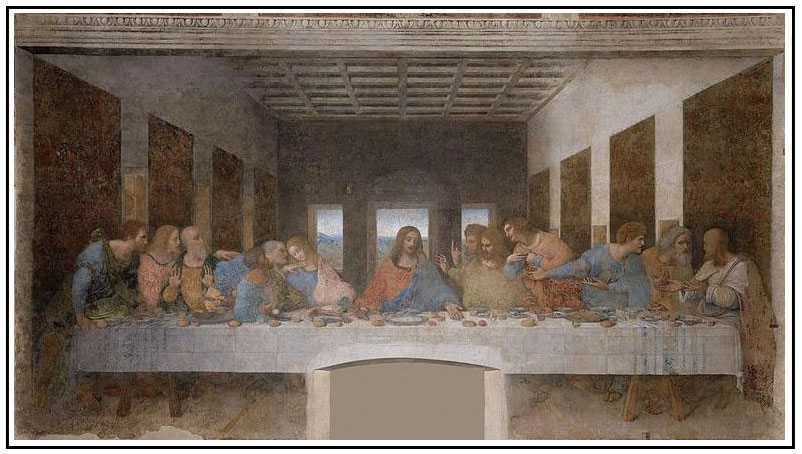
“The Mona
Lisa” (c. 1503-1506)
Oil on poplar (Louvre, Paris)
The Mona Lisa has been acclaimed as “the best known, the most visited, the most
written about, the most sung about, the most parodied work of art in the world.” The Mona Lisa is on
permanent display at The Louvre museum (Paris) since 1797.
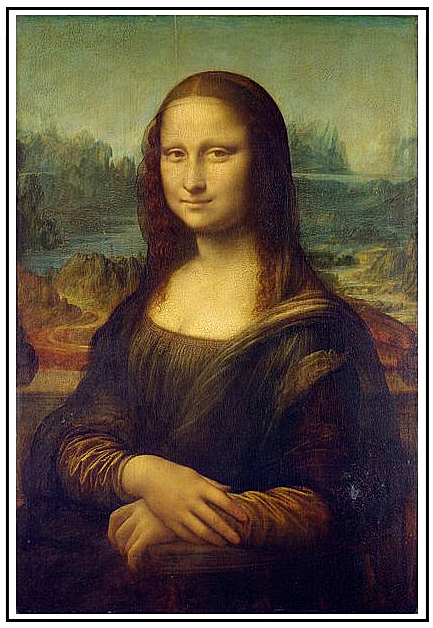
MICHELANGELO DI
LODOVICO BUONARROTI SIMONI (1475-1564)
Known as “Michelangelo”. Renaissance Italian sculptor, painter, architect, poet
and engineer. Like Da Vinci, the quintessential ‘Renaissance Man’.
“Pieta” (1499)
Carrara marble statue (St. Peter’s Basilica, Vatican City)
Establishes’ Michelangelo’s fame. Depiction of the body of Jesus on the lap of his
mother Mary after the Crucifixion.
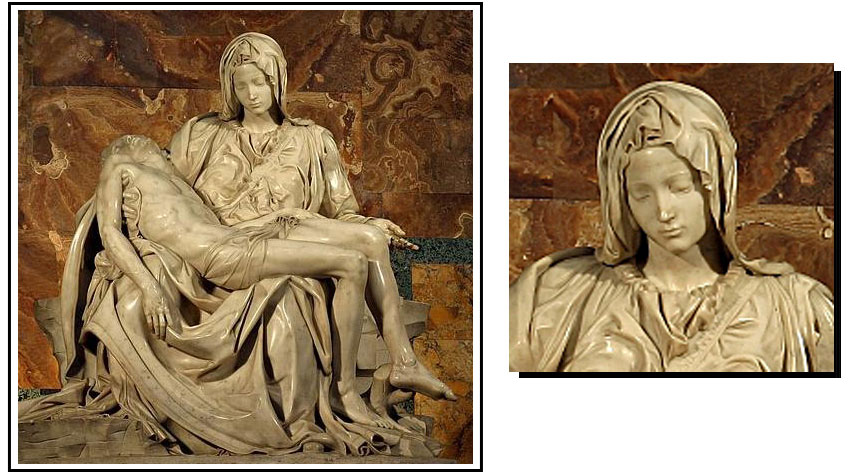
“David” (1504)
Carrara marble statue (Accademia Gallery, Florence, Italy)
David represents the Biblical hero David. ‘David’ is 17 feet high and was made
out of an abandon piece of granite.
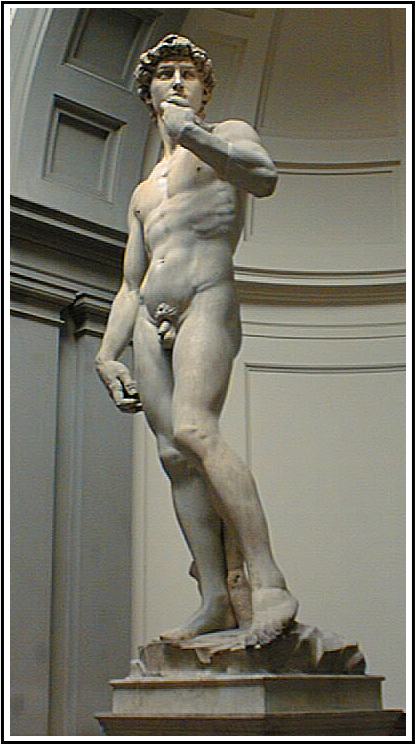
The Sistine
Chapel Ceiling (1508-1512)
Frescos (Sistine Chapel, Vatican City)
Michelangelo depicts nine scenes from the Book of Genesis. The scenes fall into three
groups: “God Creating the Heavens and the Earth”; Adam & Eve”; and the “Plight of Humanity”. The most
well-known ceiling fresco is “The Creation of Adam” (18’x 9’). Michelangelo paints man in a heroic fashion.
Cornerstone work of High Renaissance art.

“The Last
Judgment” (1536-1541)
Fresco (Sistine Chapel, Vatican City)
Influenced by the sack of Rome. Depiction of the Second Coming of Christ and
the final and eternal judgment by God of all humanity. The souls of humans rise and descend to their fates,
as judged by Christ. To Christ’s right is his mother, Virgin Mary. The two most notable saints are
surrounding the two are Saint Peter, holding the Keys of Heaven and
Saint Bartholomew with his own skin (thought to be a self-portrait of Michelangelo). Other Saints include
Paul, John the Baptist, Lawrence and Catherine of Alexandria.
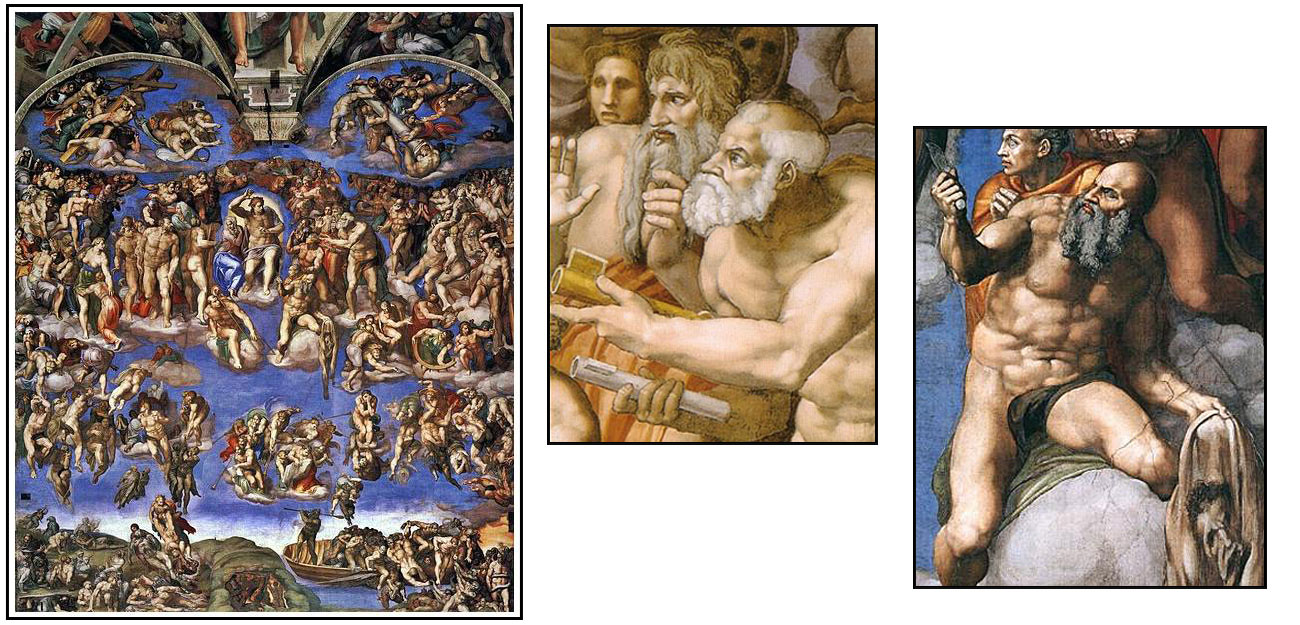
St. Peter’s
Basilica (1546-1564)
After the “Last Judgement” Michelangelo was appointed architect of St. Peter’s Basilica in 1546. The dome of
St Peter's influenced the building of churches for many centuries, including Sant'Andrea della Valle in Rome and St
Paul's Cathedral, London, as well as the civic domes of many public buildings and the state capitals across the
United States of America. After Michelangelo’s death, his spherical design was abandoned; the Dome’s ‘egg’
shape was designed by Della Porta.
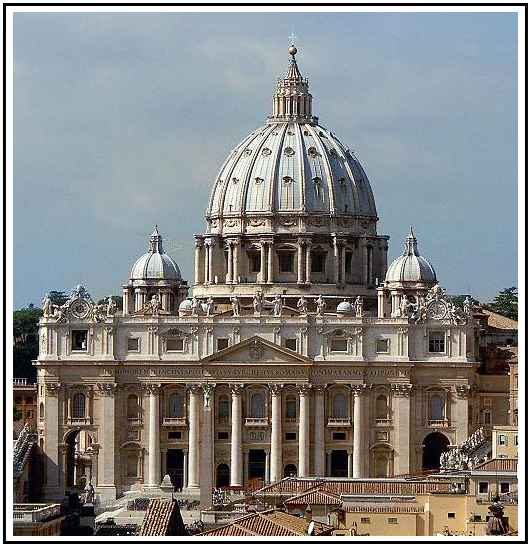
Michelangelo Angels
RAFFAELLO SANZIO DA
URBINO (1483-1520)
Known as “Raphael” – third of the great Florentine artists. Raphael’s signature
works are the frescoes within the reception rooms of the Palace of the Vatican – known as the “Raphael
Rooms”.
“Madonna of the
Goldfinch” (c. 1506)
Oil on Wood (Uffizi Gallery, Florence)
Raphael uses da Vinci’s pyramid design. The bird represents the passion of
Christ (and his death).

“The School of Athens” (1509)
Fresco (Apostolic Place, Vatican City)
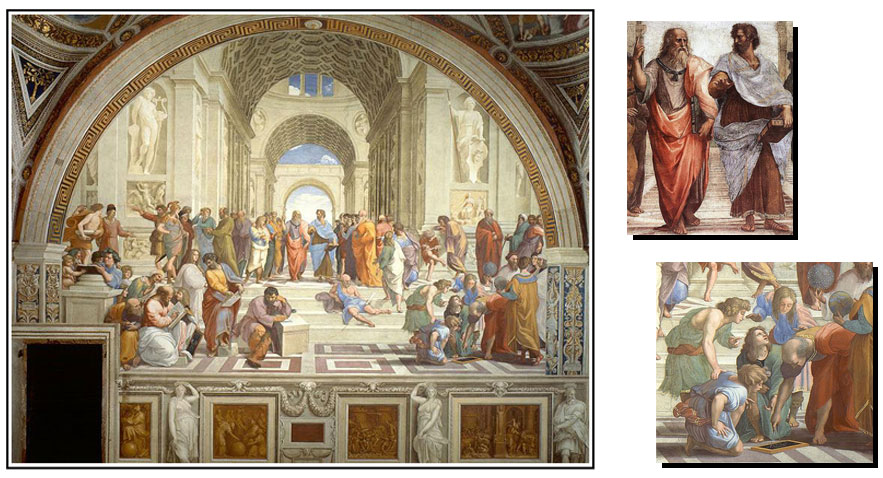
“The Expulsion of
Heliodorus from the Temple” (1512)
Fresco (Apostolic Place, Vatican City)
Located in the Stanza di Eliodoro room of the Vatican. The scene of
‘Heliodorus’ is from the Biblical episode from 2 Maccabees (3:21-28). Heliodorus is ordered by Seleucus IV
Philopator, the king of Syria, to seize the treasure preserved in the Temple in Jerusalem (~178 BC). Answering the
prayers of the high priest Onias, God sends a horseman assisted by two youths to drive Heliodorus
out.

GIORGIONE (1478-1510)
Founder of the Venetian school of Italian Renaissance painting (along with
Titian). Style known for an elusive poetic quality and mood as contrasted from the more linear draftsmanship
style (“disegno”) of the Florentine school.
“Sleeping Venus” (c.
1510)
Oil on Canvas (Old Masters Gallery, Dresden)

“Pastoral
Concert” (c. 1509)
Oil on Canvas (Louvre, Paris)
Originally attributed to Giorgione (musical and pastoral elements), but some modern
critics assign it to his pupil titian (due to the robustness of the nudes).
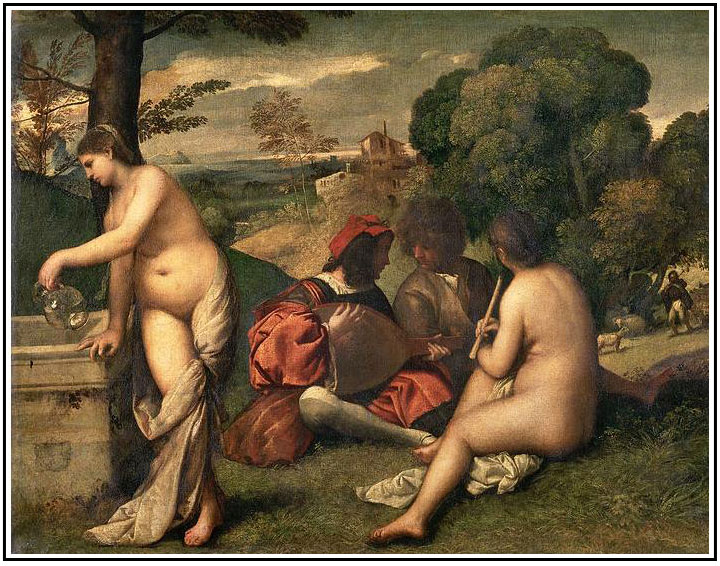
TITIAN (c. 1490-1576)
Versatile Italian artist from Venice (16th-century Venetian school) who’s painting
methods influenced many Renaissance painters as well as later generations of Western art.
“The Assumption
of the Virgin” (1518)
Oil on Canvas (Frari, Venice)
Revolutionary painting; Titian splits the scene into upper and lower sections.
It commemorates the rising of Mary to heaven before the decay of the body – a sign of her passing into eternal
life.
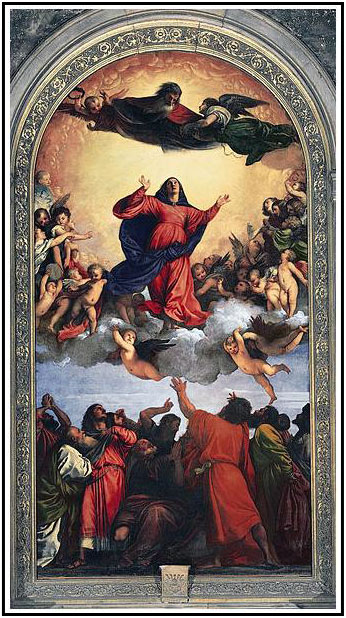
“Venus of Orbino” (1538)
Oil on Canvas (Uffizi Gallery, Florence)
The figure’s pose is based on Giorgione’s ‘Sleeping Venus’ (which he
completed). It later became the inspiration for Edouard Manet’s 1863 ‘Olympia’

Northern Renaissance
Painters
By the time of Michelangelo’s death in 1564, the
reformation of the Church, heralded by the German Martin Luther (1517), marked the end of the Pope’s universal
authority in European eccelastical matters. The establishment of the Protestant church made a notable impact
on the great artists ‘North of the Alps’. Many thinkers of the Reformation considered all art to be forbidden
graven images – especially sculptures.
ALBRECHT
DURER (1471-1528)
Durer was a German painter, engraver, printmaker and mathematician. His
high-quality woodcuts established his reputation at the great artist of the Reformation (Luther was an ardent
supporter) and is regarded as the greatest artist of the Northern Renaissance.
"Melancholia
I" (1514)
Engraving (National Gallery of Art, Washington DC)
Lord Kenneth Clark (Civilization) gives insight to “Melancholia I”, “In the Middle Ages, melancholia had meant a
simple combination of sloth, boredom and despondency…liked cooped up together in monasteries…But Durer’s
application is far from simple. This figure is humanity at its more evolved with wings to carry her
upwards. She sits in the attitude of Rodin’s Penseur (“The Thinker”) and still holds in her hand the
compasses - symbols of measurement by which science will conquer the world. Around her are all the emblems of
constructive action. A saw, a plane, pincers, and those two prime elements in solid geometry - the sphere and
the dodecahedron. And yet, all these aids to construction are abandoned. She sits there brooding on the
futility of human effort. Her obsessive stare reflects some deep psychic disturbance. The German mind
that produced Durer and the Reformation also produced psychoanalysis."
Behind her is the “Magic Square”. The two
middle cells of the bottom row giving the date of the engraving: 1514. The square's four quadrants, corners and
center also equal 34.
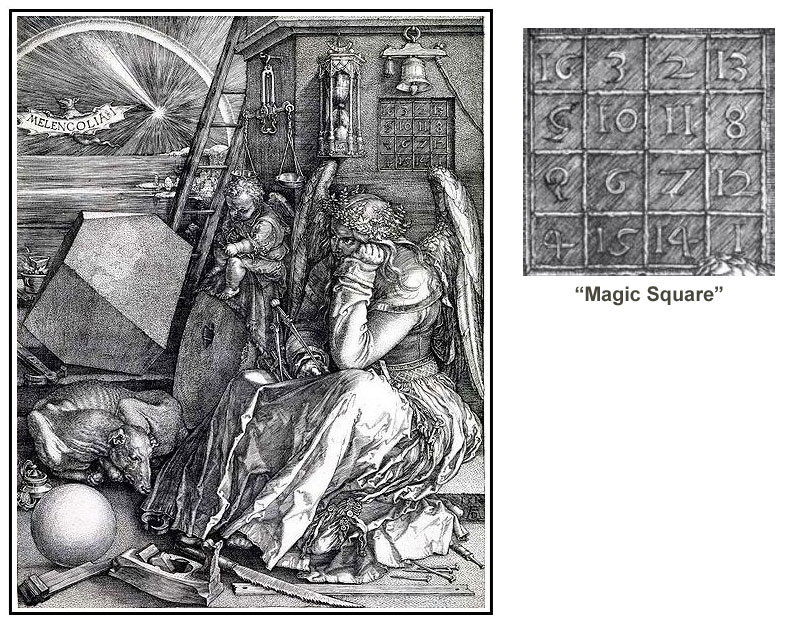
Self-Portrait (1498)
Oil on panel (Museo Del Prado, Spain)
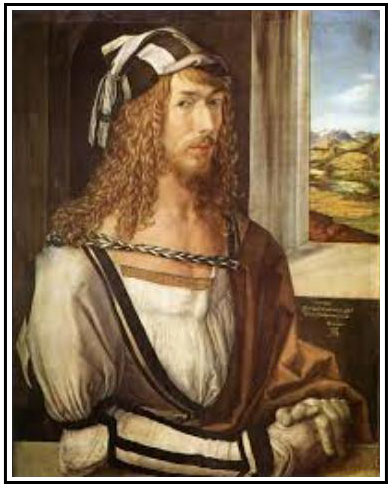
"Young Hare"
(1502)
Watercolor & Body Color (Albertina,
Vienna)

“Knight, Death and the Devil” (1502)
Engraving (Metropolitan Museum of Art, NY)
“Knight, Death and the Devil” is infused with complex iconography and symbolism, the precise meaning of which has
been argued over for centuries. Some historians have interpreted the engraving to be Durer’s homage to Erasmus of
Rotterdam (1466-1536), the Dutch Renaissance humanist, Catholic priest and theologian, where the armored knight
takes battle with the Church and to reform its teachings. In times of crisis, Erasmus took the stance that people
yearn for tolerance, reason and simplicity of life. And even for civilization.
On the tide of fierce emotional and biological impulses, the Erasmian point-of-view became powerless. "Knight,
Death and the Devil" became a propaganda tool for the Nazis as representing the racially pure Aryan. Hitler was
interpreted as the "knight without fear or blame...that cried out to the world: even if the world is full of
devils, we must win anyway!"
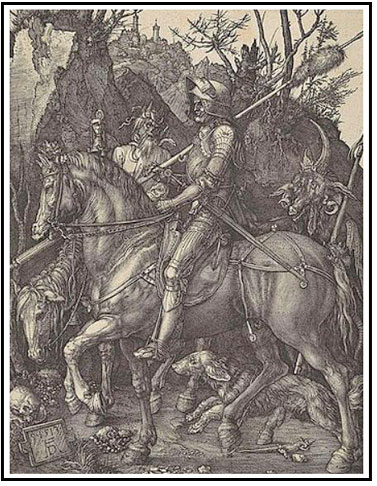
HANS HOLBEIN THE
YOUNGER (c. 1497-1543)
As the ideas of the Reformation took hold (eg, Switzerland), the artist’s traditional
role of painting religious images for churches declined. A new source of business was portrait painting of
which Holbein excelled in. Holbein’s art is often called realist, since he drew and painted with rare
precision. During the 1530’s Holbein moved to England and became a painter for King Henry
VIII.
“Virgin and
Child” (1528)
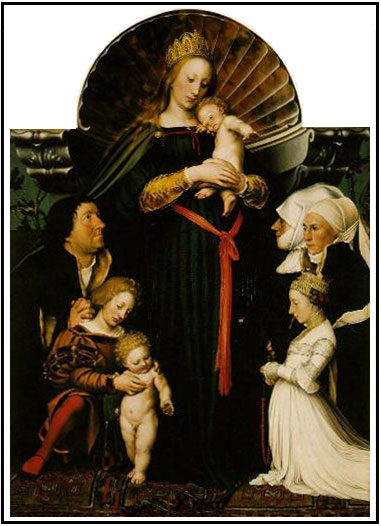
“The
Ambassadors” (1533)
A double portrait. Includes objects of learning. At the bottom of the
painting is a distorted human skull – symbol of the treachery of diplomacy, mortality.
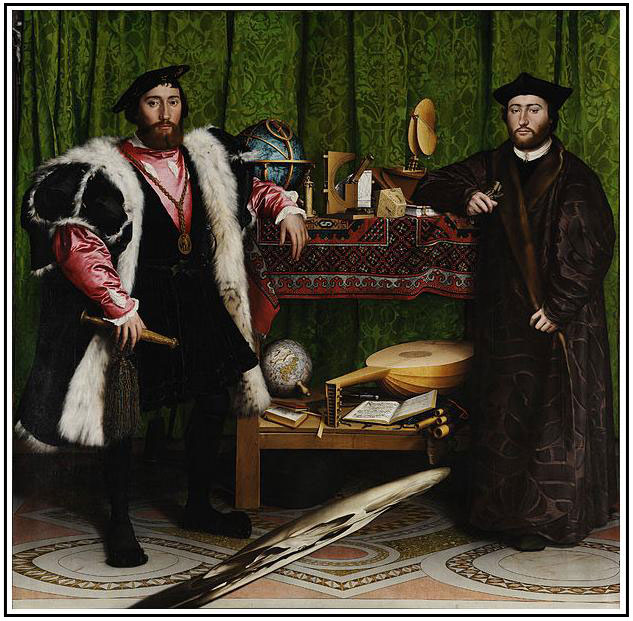
“Henry
VIII” (1536)
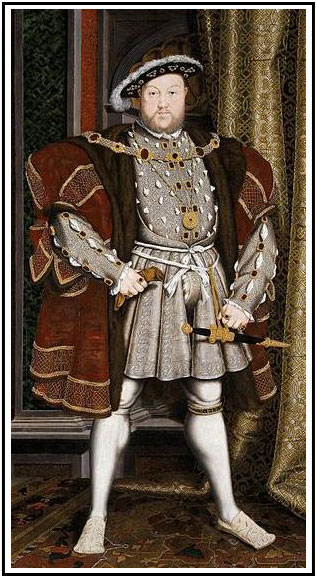
z
| 




















